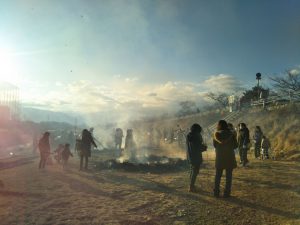Sankuro: Matsumoto’s Tradition of Burning Stuff
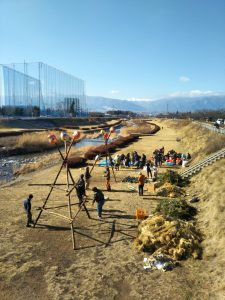
Japanese people love burning stuff. It’s true. The municipalities burn their garbage. Rice farmers burn the excess grass around their fields in summer and the chafe from the rice in the fall. In Yamaguchi they burn entire hillsides. My in-laws burn wood to heat their bath water and, since they live on a farm out in the boonies, burn everything from aluminum foil to plastic bottles to shopping bags full of shopping bags, so much so that they’ve managed to burn the steel can that used to hold it all.
And in January, once everyone has finished picking the mochi from their teeth, the Japanese burn last year’s good luck charms in a tradition known in Matsumoto as Sankuro.
It happens all over Japan, people burning the amulets and daruma dolls they bought the previous year in hopes of bringing themselves a bit of good luck. The proper term for the custom is Dondoyaki, and is performed in the belief that it is much more respectful to burn these objects rather than toss them in the trash (where they’ll get burned in the end anyway). Some will burn them at a Shinto shrine, but others choose to gather with their neighbors in fields or down by the river for something more spectacular and pyromantic.
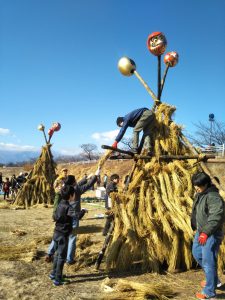
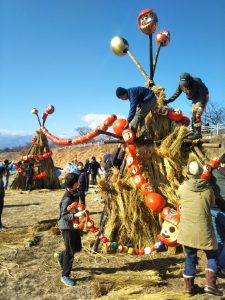
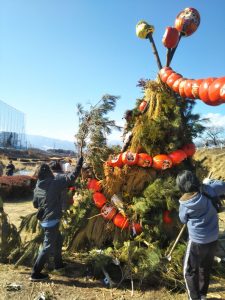 Dondoyaki is called different things in different regions – Tondo in Kansai, Sagichou in Hokuriku, Sainokami in Tohoku and, in Kyushu, Onibitaki. It is generally held on the second Sunday of January, the day before the national no-school holiday of Seijin-no-hi because, as the unofficial story goes, on Monday the kids’ eyes are all still burning from all the smoke and can’t pay attention in class anyway.If you are in downtown Matsumoto, the best place to catch all the incinerating fun is along the Metoba and Susuki Rivers. In the morning folks gather at a designated spot, bringing all their used-up daruma dolls, o-mamori amulets and whatever other objects of superstition they have from the previous year. The moms will busy themselves separating the plastic elements from the wood, straw, cloth and paper-mache burnables. The dads will construct triagular frames out of wood and rope. Meanwhile a few of the children will help build up the bonfires with pine branches and bundles of straw while the rest just run around, laughing and playing and occasionally getting yelled at for getting too close to the guy splitting pieces of bamboo with his axe. The daruma dolls get holes punched in their heads and feet and are strung up around the bonfire like popcorn on a Christmas tree. When the bonfires are ready all the kids get juice and all the moms and dads get green tea and everyone breaks for lunch.
Dondoyaki is called different things in different regions – Tondo in Kansai, Sagichou in Hokuriku, Sainokami in Tohoku and, in Kyushu, Onibitaki. It is generally held on the second Sunday of January, the day before the national no-school holiday of Seijin-no-hi because, as the unofficial story goes, on Monday the kids’ eyes are all still burning from all the smoke and can’t pay attention in class anyway.If you are in downtown Matsumoto, the best place to catch all the incinerating fun is along the Metoba and Susuki Rivers. In the morning folks gather at a designated spot, bringing all their used-up daruma dolls, o-mamori amulets and whatever other objects of superstition they have from the previous year. The moms will busy themselves separating the plastic elements from the wood, straw, cloth and paper-mache burnables. The dads will construct triagular frames out of wood and rope. Meanwhile a few of the children will help build up the bonfires with pine branches and bundles of straw while the rest just run around, laughing and playing and occasionally getting yelled at for getting too close to the guy splitting pieces of bamboo with his axe. The daruma dolls get holes punched in their heads and feet and are strung up around the bonfire like popcorn on a Christmas tree. When the bonfires are ready all the kids get juice and all the moms and dads get green tea and everyone breaks for lunch.
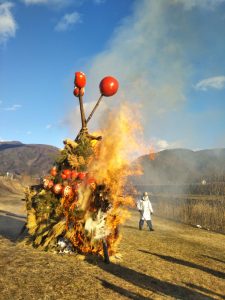
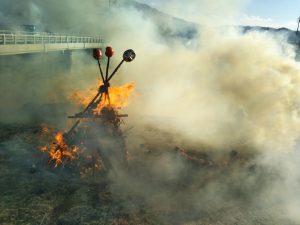 In the afternoon everyone gathers once more, this time along with a crew of firemen standing by in full protective gear. When the clock ticks fire o’clock the neighborhood kids with the most pent-up aggression are given the honor of sticking rudimentary torches to the straw and within minutes the air is filled with thick brown smoke that swirls into everyone’s eyes, making the children scream in blinding pain. The firemen are then tasked with watching the flames while simultaneously making sure none of the children now running around in crazed desperation end up underneath the soon-to-collapse bonfire.
In the afternoon everyone gathers once more, this time along with a crew of firemen standing by in full protective gear. When the clock ticks fire o’clock the neighborhood kids with the most pent-up aggression are given the honor of sticking rudimentary torches to the straw and within minutes the air is filled with thick brown smoke that swirls into everyone’s eyes, making the children scream in blinding pain. The firemen are then tasked with watching the flames while simultaneously making sure none of the children now running around in crazed desperation end up underneath the soon-to-collapse bonfire.
It doesn’t take long for these three-meter pyres to turn to smoking, smoldering heaps of ash and daruma remains. From there the kids all gather round to toast their mayudama, colored rice cake balls that have been skewered to thin, drooping willow branches. After five or six seconds the smoke and the heat get to be too much and they hold their branches out, blindly as they cover their stinging eyes, waiting for mom or dad to take over. Much drier and denser than marshmallows, these mayudama take a short eternity to roast to an acceptable if not edible softness. The silver lining here is that the drawn-out anticipation of eating the things makes one less attuned to the fact that they taste a lot like cardboard.
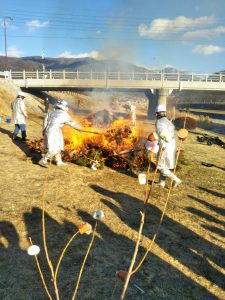
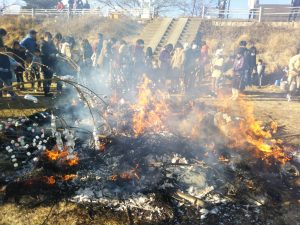
Sankuro is good community fun. If you were around for it this past weekend then surely you know what I mean. If you missed it, be sure to mark your calendar now for Sankuro next January. Then take a walk along the river and see for yourself what fun burning stuff can be! And yeah, wear old clothes.
